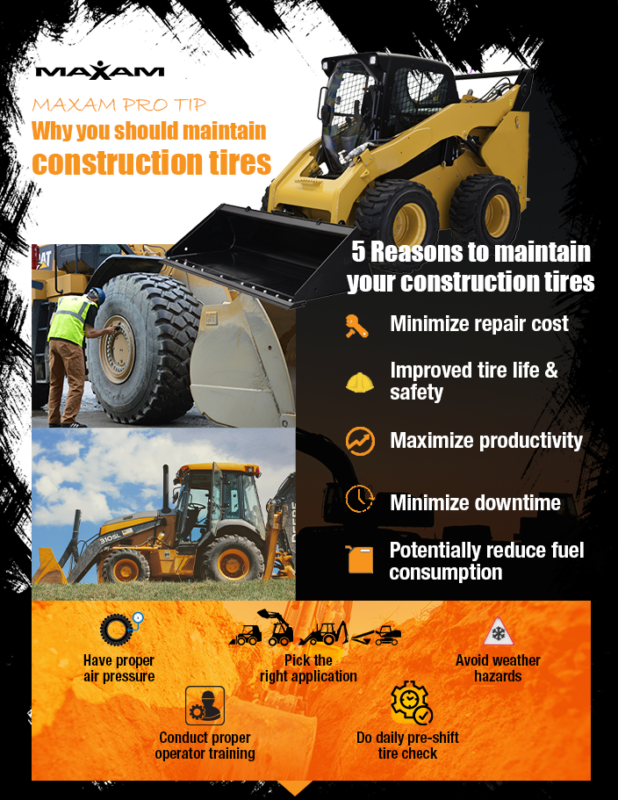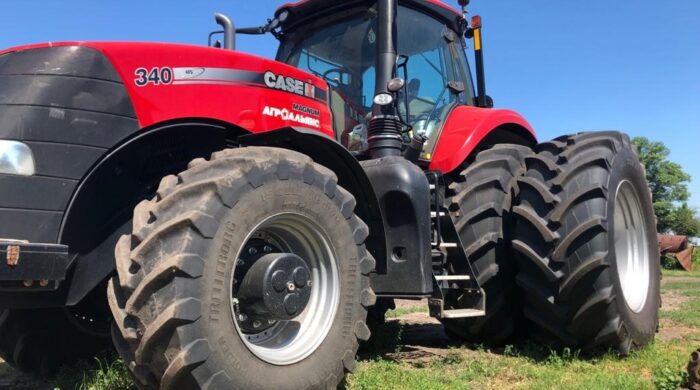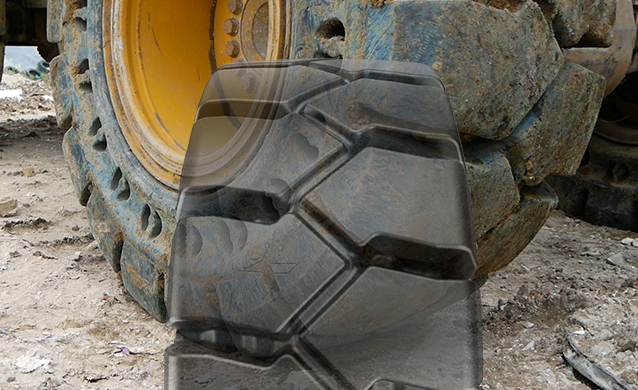How to best maintain your construction equipment tires
In addition to maintaining your construction equipment, maintaining your construction machine’s tires is equally important to run an efficient operation. By maintaining your construction tires, it’ll have a direct impact on your bottom line with the following attributes:
- Minimize repair cost.
- Improve tire life and overall operation safety.
- Maximize operation’s productivity.
- Minimize downtime.
- Potentially reduce fuel consumption.
Here are five factors to consider when it comes to construction equipment tire maintenance:
- Air pressure
- Picking the right application
- Avoid weather hazards
- Conduct proper operator training
- Conduct pre-shift daily tire check
I. Air pressure
One of the most important factors on maintaining your construction tires, bias, or radial, is air pressure. Always check your tires’ air pressure daily, ideally before each shift, especially on a “cold” tire. Below is how a “cold” tire versus a “hot” tire is defined:
| Cold tire | Hot tire |
| A cold tire is generally defined as one that has been sitting idle and not used for a minimum of 24 hours. From this point the pressure can be monitored more accurately. | As a tire works, its internal temperature will increase, as will its air pressure. A hot tire must never be deflated.
– If the air pressure increases by 20% or more from the cold inflation reading, it’s a sign that the tire is overheating and should cool down or moved to an operation that is less demanding. |
If you have an underinflated tire, you risk the potential of heat buildup, leading damage to the sidewall, bead and lining. A drop of simply 5 psi can lead to 10% drop in load carrying capacity, and a drop of 10 psi can lead to 10% drop in overall tire life.
Similarly, if you have an overinflated tire, it leaves your tire being vulnerable to impact damage as additional pressure can stress the tire casing.
In general, failure to maintain proper air pressure will cause the tire to:
- Have excessive wear
- Tire component separation
- Tire rim slip
- Reduced tire life and productivity
In addition to air pressure, always remember that if you need to increase load, you must increase the air inflation pressure to match the tire to the load. Maxam Tire provides the exact speed symbol, load carrying capacity and the proper psi that correlates to each tire on our product catalog. Always refer to this information when you need to increase air pressure based on load carrying capacity.
Never run excess load continuously on your construction machine for too long, even if it’s based on the proper carrying load and speed, because it’ll shorten your tires’ performance and overall life significantly.
II. Picking the right application
Having the right type of tire for your application is equally important as maintaining proper air pressure. Contractors should always consider the machine type, what type of jobs that machine does most of the time and pick the right tire accordingly.
Below are two cases on backhoe and how each backhoe’s job determines what tires to pick.
| Backhoe #1 | Backhoe #2 | ||
| Types of job | Tire to choose | Type of job | Tire to choose |
| Majority of its life is softer soil (where traction is needed); digging using the front bucket, this is the one that matters. | R4 pattern for better grip in soil that cleans out better as you’ll be utilizing the front bucket to for clean up jobs. | With harder surface majority of its life, select a tire with more rubber for more contact surface. | Select a tire with a L5 pattern because it offers more rubber contact in addition to taking scrub better when turning. |
Sometimes having a rubber track for your application could be the ultimate solution. For example, landscape crew moving rocks on a skid steer should consider having rubber tracks instead of tires. This is due to the importance of soil compaction, by carrying the same amount of load on a rubber track, you can disperse that load with the greater contact area, providing least amount of compaction on the lawn and the roots.
III. Avoid weather hazards
Always inspect critical areas on your tires before the changing season, areas to inspect on your tires include:
- Valve stem: any issues at the bead and rims, anything bent?
- Bead and rims: are the valve stems good and tight; do you have valve caps, cords leaking?
- Sidewall: Sidewall: fatigue cracking inside and out? Inspect the inside and look for any bubbles, golf balls sticking out (indication of impact damage).
- Face of the tire: steel belting, bulge, lug tearing off?
After your tire inspection, avoid the following operation despite of weather hazards:
- Spinning tires excessively: don’t push too hard as it’ll create heat buildup, which is ultimately can shorten tire life.
- Avoid puddles: water is a lubricant on rubber, if something sharp is hidden, running over them could cut the tires.
- Slow down: excess speed will increase heat buildup (remember your carrying capacity).
To learn more, check out this article where we reveal further weather hazards and how to avoid each seasonal tire hazards.
IV. Pre-shift Tire Check
Tires should be visually inspected before every shift for cuts and impacts that could lead to tire failure. Routine maintenance inspections can lead to discovering deeper cuts that have exposed plies. In these cases, removing the tire and repairing it immediately can extend the life of the tire, increasing site’s profitability.
Below are the basic components on the tires you should always inspect before each shift daily:
- Check the face of the tire
Check for cuts and tears on the face of the tire. Is anything missing? Has the lug torn off?
- Check the bead
Run your hand all around where the tire meets the wheel. Is it consistent all the way around.
- Check the valve stem
Check the core. Is it leaking? Is there a cap on the valve stem? Is it tight? Is the valve stem properly seated on the wheel? All of this can be checked by spraying a little bit of soapy water on the stem. If you see bubbles, you may have a leak.
- Check the air pressure
Make sure the air pressure is at the recommended level.
V. Proper operator training
Having a good operator training is essential to not only outlasting your construction equipment, but also your tires. When conducting your operator training, consider the following attributes:
- Avoid these moments: unnecessary backing up, spinning of tires, erratic movements.
- Know your best driving path: be aware of the layout in the working area and carefully plan their routes. How steep are the slopes? Are there areas or deep mud or hard-to-spot hollows? Going around an obstacle or mound or steep incline may take a little longer, but the savings in fuel and tire damage may well make it worthwhile.
In summary, if you abide to the top five tips we have mentioned above in maintaining your construction equipment tires, you will notice a significant difference in maximizing your operation cost-per-hour and having the best productivity. For more tire tips to maximize your operation, check out our technical bulletin.
Downloads:
Weather Extremes and Construction Tire Maintenance
MAXAM ROTR Tire Pressure Guide
Watch our webinar:
Learn helpful tips to maintain the tires on your construction equipment such as skid steer, backhoes, front wheel loaders, etc. In addition to picking the right tire size and selecting a certain tread design, contractors should consider other factors like seasonal maintenance, the importance of air pressure, how to extend tire life and conduct pre-shift tire check.




